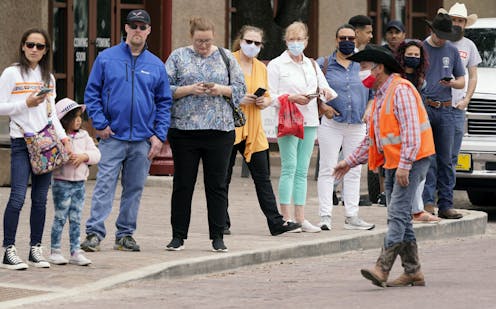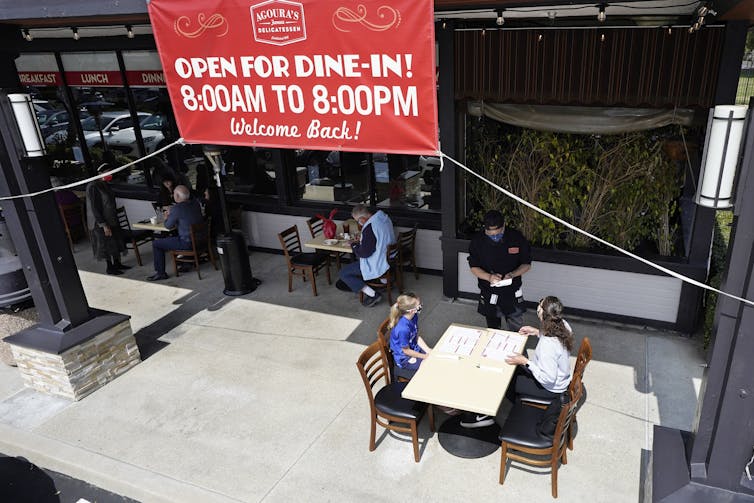US could save tens of thousands of lives and tens of billions of dollars with 3 weeks of strict COVI
Texas and many other states have eased all or most coronavirus restrictions such as mask-wearing. A cost-benefit analysis suggests reversing those moves for just a short period could make a big difference.

President Joe Biden commemorated the COVID-19 pandemic’s one-year anniversary by giving Americans an ambitious goal: Return to a semblance of normalcy by the Fourth of July.
“But to get there we can’t let our guard down,” he added.
Unfortunately, many states already have. Falling numbers of new coronavirus cases and accelerating vaccination rates have prompted Texas and a growing number of other states to ease more restrictions or drop them altogether. Their governors argue the economic costs are just too high and the measures no longer necessary.
Federal health officials, meanwhile, are advising states to hold off on reopening too soon and urging Americans to continue to mask up and take other precautions in public – even if they’re fully vaccinated. About 1,500 people in the U.S. are still dying every day.
The states easing COVID-19 restrictions seem to be valuing the gains from doing so over the lives of the citizens who may die as a result.
Fortunately, my field of finance offers a way to assess whether this is the right approach or whether the states are making a mistake: conduct a cost-benefit analysis.
Putting a value on life
I published a paper earlier this year – different versions of which were peer-reviewed by Covid Economics and Economics of Natural Disasters and Climate Change (forthcoming) – that performs such an analysis and explains my methodology and assumptions in detail. For this article, I updated the results in my model with the latest figures as of March 13.
A key piece of data you need to know for a cost-benefit analysis is the value of a human life.
Assigning a dollar value to a life may seem strange, but it is something that policymakers do routinely, such as when evaluating the benefits of new regulations. One way to do this is to try to assess the value people put on their own lives. Economists infer this from an individual’s willingness to pay in order to increase the probability of staying alive.
For example, how much extra pay does a worker demand to do a riskier job like in construction that is more likely to result in an injury or death? Or how much are consumers willing to spend on medical interventions or safety equipment in order to reduce the probability of dying?
Resulting estimates produce the “value of a statistical life” – jargon for how much a human life is worth monetarily. This number typically decreases as people age.
The calculations I used in my analysis are based on a recent report by the White House Council of Economic Advisers, with slight modifications to better match other data sources I referenced in my analysis. The value peaks at US$12.3 million for people aged 20 to 44 and declines until it reaches $5.3 million for those 65 and up.
Of course, since most symptomatic COVID-19 cases do not end up in death, I also needed to figure costs due to lost productivity and the medical resources used up when someone gets sick. Since some people merely lose a few days of work, while others may spend weeks in the hospital, it was important to find a way to estimate this. These impacts also increase with age. And so I analyzed probable sick days depending on age and put a value on the loss of productivity.
How tighter restrictions may help
The next consideration is figuring out how many illnesses and deaths could be prevented by adopting stricter COVID-19 measures.
First we must decide which restrictions will make the most difference. After a year of studying the virus, health officials generally agree that the most effective interventions include mandating face coverings, limiting indoor gatherings and requiring physical distancing. Other important measures include closing nonessential businesses, restricting travel from heavily affected areas and maintaining widespread testing and contact tracing.
Currently, businesses are “mostly open” in all but eight states, while masks are still required in a little over half of them.
To project the number of future cases, I used a standard epidemiological model that estimates how various factors alter how many people get sick and recover or die from a disease. The model allows me to incorporate assumptions concerning the implementation of coronavirus restrictions nationwide as well as expected vaccination rates that I assume will continue at the current pace of about 2.5 million doses a day.
The model estimates that between now and September, when I project the pandemic should be largely over in the U.S. because of herd immunity, nearly 5.5 million more people will likely get sick and 65,000 people will die, if the current level of restrictions – like mask mandates and business closures – remains in place. If states continue to ease their restrictions, these estimates would rise, while if vaccinations accelerate, they would decline.
But if all states adopted – or were forced to adopt – all the restrictions listed above for a period of three weeks, the model projects that about 4.5 million fewer people would get sick and 54,000 fewer would die.

Only three weeks
To some people, merely knowing how many lives could be saved is enough to convince them that a short period of tightened restrictions makes sense. The cost-benefit analysis, however, puts everything in monetary terms – using the “value of a statistical life” numbers mentioned earlier – and may be more persuasive for others who are more skeptical.
My analysis shows the economic value of lives saved and illnesses avoided, based on these assumptions, totals nearly $339 billion. That’s basically the “benefit” to the economy of putting in place three weeks of tightened restrictions nationwide.
To figure the “cost” part of the analysis, I reviewed a few different studies that estimated the costs to the economy of coronavirus restrictions. I concluded that the economy would lose nearly $37 billion every week that restrictions like closure of nonessential businesses and mandated social distancing are imposed. The costs could be higher depending on if the restrictions trigger any bankruptcies or other businesses costs, which are very hard to project.
That adds up to about $111 billion over three weeks, after which I assume states would ease those restrictions and revert to their current policies.
So the net cost savings of imposing three weeks of restrictions would be nearly $228 billion. As the U.S. nears herd immunity, the cost-benefit analysis shows the costs of restrictions will eventually outweigh the benefits – but more people will have died as a result.
Admittedly, this is based on many assumptions, and it’s virtually impossible to get all of them right. Forecasting the number of deaths and illnesses is especially hard, and you’ll get different estimates from sources like the Centers for Disease Control and Prevention. And it’s possible the vaccines will lose their effectiveness over time to existing or new variants that emerge.
Furthermore, cost-benefit analyses aren’t meant to be predictions; they simply help guide decision-making. But regardless of how I crunched the numbers, I still reached the same conclusion: Imposing a period of tighter restrictions now – even for just one week – will save a lot of lives, offering greater economic benefits than costs.
Now’s not the time to ease up
In other words, now seems to be exactly the wrong time to ease and eliminate restrictions as some states are doing, especially with several new variants remaining a threat.
In fact, I tested a hypothetical scenario in which the more transmissible B.1.1.7 variant becomes the predominant one in the United States. As a result, the calculations in my paper showed that the estimated net benefit of temporarily imposing tighter restrictions nearly triples.
Anthony Fauci, the government’s top infectious diseases expert, called decisions to ease mask mandates and other restrictions “risky business” and warned that the U.S. could see another surge in cases – as Europe is experiencing now – if it lifts restrictions too soon.
My analysis suggests the U.S. should go even further. It not only would save lives but makes economic sense too.
[Over 100,000 readers rely on The Conversation’s newsletter to understand the world. Sign up today.]
Anna Scherbina does not work for, consult, own shares in or receive funding from any company or organization that would benefit from this article, and has disclosed no relevant affiliations beyond their academic appointment.
Read These Next
Chile elects most right-wing leader since Pinochet – in line with regional drift, domestic tendency
José Antonio Kast, who has run for the presidency several times, successfully seized on widespread…
Epstein’s victims deserve more attention than his ‘client list’
Powerful men connected to Jeffrey Epstein are named, dissected and speculated about. The survivors,…
The ‘one chatbot per child’ model for AI in classrooms conflicts with what research shows: Learning
AI tutors are often held up as an ideal, but prioritizing individualized teaching can detract from the…






